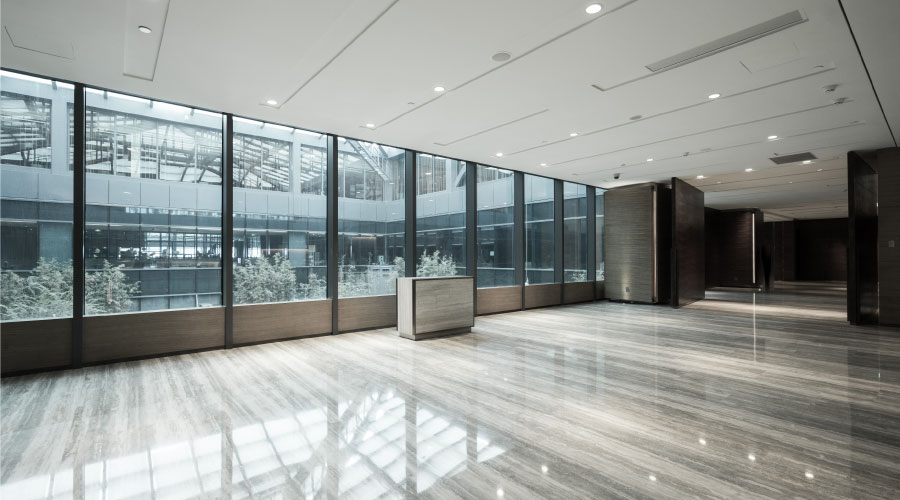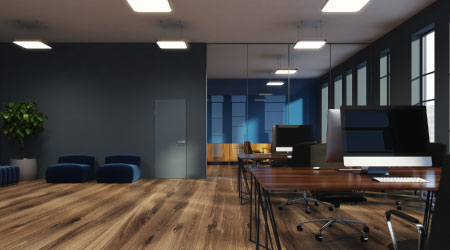Flooring
Resilient flooring choices abound
Resilient flooring is turning up in new places with a new generation of rubber, laminate, linoleum, vinyl and polymer products. Manufacturers tout durability, hygiene, easy maintenance and new aesthetic options as reasons resilient flooring is worth a look. Hospitals, schools, grocery stores and discount stores have been among the first to capitalize on expanded color palette offered by resilient flooring makers. These floor covering options are also turning up in office buildings, hotels, entertainment venues, restaurants and other public spaces.
So what’s all the fuss about flooring? The new colors and textures allow designers to use the floor to create way-finding systems or create cohesiveness or transition among various spaces, says Dominic Rice, vice president of product management, commercial floors, for Armstrong World Industries.
“For designers, first and foremost, the floor has to look good,” says Dennis Schmick, president of nora Rubber Flooring. “They were often disappointed to find the design couldn’t withstand the function. They needed solutions that would look good and not be hard to maintain.”
Given the range of resilient flooring options, the challenge is to determine which product best suits a space, says Diane Martel, vice president of marketing for Tarkett Commercial Flooring. In wet spaces, a product with a sealed surface that can be hosed down if necessary is likely a better choice than a product made from natural materials that expand when continually exposed to water and chemicals.
Facility executives should consider what kind of traffic is typical for the area. Will it be subject to foot traffic only or will heavy carts and machines roll over it as well? Is slip-resistance an issue? When it comes to selecting a product that meets all the criteria for a space, there may be more than one answer, Rice says.
Ultimately, life-cycle costs should be the deciding factor. While life-cycle costs begin with the initial capital outlay for the product and installation, they don’t stop there. Maintenance is a significant element of the equation. Some products require stripping, dressing and buffing while others require little more than sweeping.
For example, a product with a low purchase price but high maintenance costs may not be more expensive to own than a product with higher initial costs but lower maintenance expenses.
Life span is another issue for facility executives to consider. Some resilient floors can last 20 or more years, but many spaces are remodeled every few years. Purchasing a 20-year product when, realistically, it will be changed in five years is not cost-effective, says Harold Chapman, chairman emeritus of Starnet.
Sorting out Options
Traditionally, rubber flooring was limited to heavily traveled spaces where looks didn’t matter. Stock trading floors, transportation facilities such as parking access areas and stairwells were once the most common places to find rubber floors, Schmick says.
Thanks to significant developments in the last few years, rubber flooring is now available in a range of colors. Advanced cutting and installation techniques further expand creative options, making it suitable for spaces where looks are important.
Managers of health care, educational, recreational and laboratory research facilities are turning to rubber because of its slip-resistance, cushioning properties and sound-dampening characteristics, says Jeff Krejsa, director of marketing for Johnsonite Flooring.
“You have to think about how that space motivates individuals,” he says. “If the environment itself is inspiring and employees stay late, what would that mean in terms of return on investment? That’s not to say flooring does that by itself, but it can contribute.”
From a practical standpoint, rubber is a forgiving material, able to withstand the abuse of heavy equipment and harsh chemicals, such as acetone and disinfectants. Rubber flooring is naturally resistant to mold and bacteria. It’s also PVC free, says Ashley Gassaway, a representative for FLEXCO.
Surprisingly, rubber flooring is finding its way into commercial kitchens. In the past, the problem had been that rubber floors soaked up grease and oil.
“Before, rubber could not be used around kitchens where animal fats were present,” Gassaway says. Today, manufacturers are developing new product lines that repel grease and oil instead of absorbing it, making it easier to clean.
Polymer flooring has found a market with mass retailers, says David Motyl, chief executive officer of Amtico International America. Retailers like it because it is durable and attractive.
Polymer flooring also is finding its way into hospitals, hotel rooms and offices. One reason for the interest in the product, says Motyl, is that hygiene is an increasingly important issue in many different types of buildings.
Polymers can mimic the look of wood, stone and other natural materials. For example, wood grain tiles can be cut into planks to complete the illusion of a hardwood floor, at a fraction of the cost, Motyl says.
High-pressure laminate products also provide the appearance of wood with lower installation and maintenance costs. Commercial high-pressure laminate is thicker than residential versions. It has a higher resistance to impact and a static load rating of 2,500 psi, Phillips says. It’s also stain-resistant. Since laminate floats on cushion, most installations require no adhesives.
Linoleum and vinyl aren’t new to the commercial market segment, but like other resilient floorings they’re enjoying renewed popularity thanks to new designs, better performance and fewer maintenance hassles.
New vinyl products can provide the look of wood, granite, stone or marble without the maintenance requirements of those types of flooring, says Dee Dee Brickner, representative for Roppe Corp. Many new vinyl products are self-coving for easy installation and have built-in anti-microbial characteristics and nonporous, homogeneous construction.
Maintenance Needs
Maintenance requirements are always an issue when a new floor covering is being considered. While there’s no such thing as “maintenance-free,” the new generation of resilient flooring allows buyers to select adaptable to various maintenance routines. Consistency with the maintenance requirement in other parts of the facility is one factor to be considered. “I’d want as much of a common maintenance regime as possible,” Rice says.
While various products have different maintenance recommendations from the manufacturers, some basic principles apply across the board. “You have to keep the loose dirt and dust off, and then you have to wash it when dirt builds up,” Schmick says.
How often the janitorial staff cleans the floor is generally a function of how the space is used. A wet area in a healthcare setting is subject to more frequent attention than an office corridor.
A major maintenance consideration is the finish. Floor coverings that require routine finishing are more expensive to maintain than those that don’t.
Keeping it Green
More and more flooring buyers are adding “environmentally friendly” as a requirement to their spec sheets.
However, that term has many interpretations. It can refer to products made from recycled or post-industrial materials. It can mean that the product can be reclaimed at the end of its life. Or it can mean that the product has low volatile organic compound (VOC) emissions. Facility executives should therefore be precise in their definition when they ask for “green” products.
Rubber flooring can be made from up to 100 percent post-consumer products — ground up tires, Krejsa says. But these floors come only in black. Still, the product is thick and cushiony, making it suitable for sports facilities, such as gyms, and spaces where a certain ambiance is desired, such as sporting good stores.
Linoleum is made from renewable resources — flax plants and cork powder. Flooring manufacturers get cork tissue from post-industrial materials — leftovers from the production of bottle stoppers. Linoleum content also can include remnant product returned from new installations, Martel says.
Resilient flooring cannot be recycled, Martel says. The reason is the adhesives used to glue down the floors aren’t recyclable.
“We don’t want to put those chemicals back into the product,” she says.
In most product lines, manufacturers have reduced VOC emissions to meet the most stringent of standards and help earn points toward LEED certification.
Until recycling becomes feasible, flooring experts say capitalizing on the long life of resilient flooring is perhaps the best way to save landfill space.
Lynn Proctor Windle, a contributing editor for Building Operating Management, is a freelance writer who has written extensively about real estate.
Related Topics:











